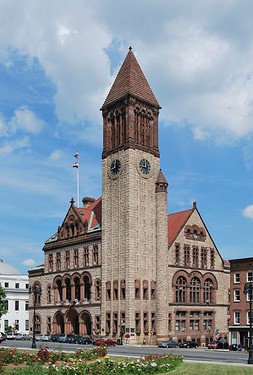Albany City Hall
Introduction
Text-to-speech Audio
A striking example of Romanesque architecture, Albany City Hall was completed in 1883, replacing the previous one destroyed by fire in 1880. Many consider it among the most attractive buildings in the United States. Built of rusticated granite and brown limestone trim, if features a 202-foot tall tower, numerous arches, decorative terra cotta floral and geometric designs, and carved stone relief sculptures of gargoyles and other figures. The tower houses one of only 116 concert carillons in the country (a carillon is instrument of bells played by a keyboard). Albany City Hall was added to the National Register of Historic Places in 1972 and is a contributing property of the Lafayette Park Historic District, which is also listed on the register.
Images
Albany's City Hall was added to the National Register of Historic Places in 1972. The tower features one of only 116 concert carillons in the country.

Backstory and Context
Text-to-speech Audio
During the colonial era, Albany's original city hall was known as "Stadt Huys"—the Dutch term for a city hall—and It appears it was built around 1635. The three-story brick building was housed the city hall offices, county court, and prison. It was also used as a state house and a venue for various gatherings including conventions and councils. The roof featured a cupola housing a bell manufactured in Holland.
The name Stadt Huys stuck even after the English took control of the area around Albany. In 1754, the Stadt Huys was the location of the Albany Congress where Benjamin Franklin proposed his plan (the Albany Plan of Union) to create a federal union of colonies under British authority. In 1832, a new city hall designed by Philip Hooker was built and remained in use until, as alluded to above, a fire destroyed it in 1880. The city hired architect Henry H. Richardson to design the present city hall building. The cost of the project doubled in size, forcing Richardson to focus his attention on the exterior since the city did not have enough money at the time. As a result, the interior was not finished until 1918.
Two years later, Albany native, government official, and carillon expert William Gorham Rice, proposed the idea of installing a carillon in the tower to honor the service members who died in World War I. However, it wasn't until 1926 when the Kiwanis Club formed a committee to move the idea forward. Over the next few months, thousands of people donated funds totaling $45,000. The city hired the John Taylor Company, which was based in England, to build the carillon. It has 49 bells; the smallest of which weighs 27 pounds and the largest weighs 11,200 pounds. It was first performed on September 18, 1927 by Belgian Jef Denym (this was his first concert on North America). Since then a number of the best carillonneurs in the world have played the carillon, including during the annual congress of the Guild of Carilloneurs of North America in 1950. In 1986, the carillon was restored and two bells were added.
Sources
"City Hall." City of Albany. Accessed January 14, 2024. https://www.albanyny.gov/519/City-Hall.
"History of the Albany Carillon." Albany Carillon. Retrieved from the Web Archive on January 15, 2024. https://web.archive.org/web/20110724231703/http://www.albanycarillon.org/history.htm.
Wikimedia Commons: https://commons.wikimedia.org/wiki/File:AlbanyNYCityHall.jpg
